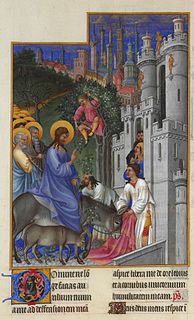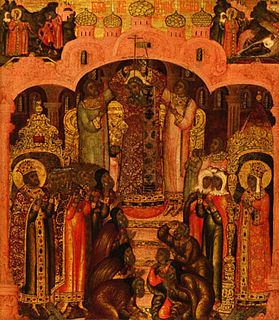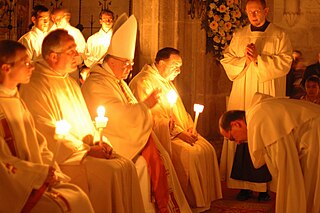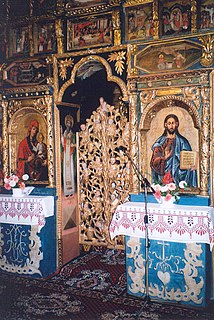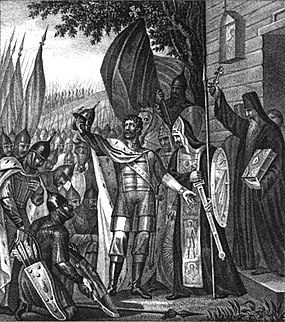The sacred Hexapteryga are used in the Eastern Christian Churches (including Eastern Catholic Churches, Eastern Orthodox Churches and Oriental Orthodox Churches) during services. [1] [2] Ripidions are carried by the altar servers at all processions with Eucharistic gifts and the Gospel book. [3]
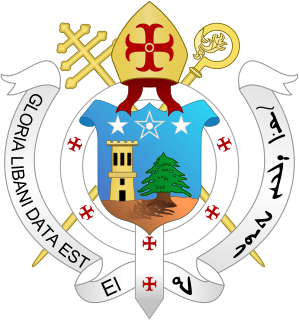
The Eastern Catholic Churches or Oriental Catholic Churches, also called the Eastern-rite Catholic Churches, and in some historical cases Uniate Churches, are twenty-three Eastern Christian particular churches sui iuris in full communion with the Pope in Rome, as part of the worldwide Catholic Church. Headed by patriarchs, metropolitans, and major archbishops, the Eastern Catholic Churches are governed in accordance with the Code of Canons of the Eastern Churches, although each church also has its own canons and laws on top of this, and the preservation of their own traditions is explicitly encouraged. The total membership of the various churches accounts for about 18 million, according to the Annuario Pontificio, thus making up about 1.5 percent of the Catholic Church, with the rest of its more than 1.2 billion members belonging to the Latin Church, also known as the Western Church or the Roman Catholic Church.
Liturgy is the customary public worship performed by a religious group. As a religious phenomenon, liturgy represents a communal response to and participation in the sacred through activity reflecting praise, thanksgiving, supplication or repentance. It forms a basis for establishing a relationship with a divine agency, as well as with other participants in the liturgy.

In the Eastern Catholic Churches and Eastern Orthodox Churches, the sacred εξαπτέρυγον, hexapterygon, plural: εξαπτέρυγα hexapteryga—literally, "six-winged"), have been used from the first centuries to the present day. It is generally made of metal, round, having the iconographic likeness of an angel with six wings, and is set on the end of a pole. Hexapteryga of carved, gilded, or painted wood are also found. They are usually made in pairs. For historical use in the Western Church see flabellum.

An icon is a religious work of art, most commonly a painting, in the cultures of the Eastern Orthodox Church, Oriental Orthodoxy, the Roman Catholic, and certain Eastern Catholic churches. The most common subjects include Christ, Mary, saints and angels. Although especially associated with "portrait" style images concentrating on one or two main figures, the term also covers most religious images in a variety of artistic media produced by Eastern Christianity, including narrative scenes. Icons can represent various scenes in the Bible.

A flabellum, in Christian liturgical use, is a fan made of metal, leather, silk, parchment or feathers, intended to keep away insects from the consecrated Body and Blood of Christ and from the priest, as well as to show honour. The ceremonial use of such fans dates back to Ancient Egypt, and an example was found in the tomb of Tutankhamun. A flabellum is also a fan-shaped structure on the fifth legs of horseshoe crabs (Xiphosura).

Among the Eastern Catholics and Eastern Orthodox, the hexapteryga will be carried during the Great Entrance and at all processions; in the Russian churches they are often also used to honour a particularly sacred icon or relic. When not in use, the hexapteryga are usually kept in stands behind the Holy Table in the Byzantine Eastern Catholic Churches and Greek tradition, and in the Slavic traditions may either be kept there or out of sight elsewhere in the altar. The latter is especially true in northern Russia, where icons of Christ and the Theotokos are usually placed behind the Holy Table.

A procession is an organized body of people walking in a formal or ceremonial manner.

The Russian Orthodox Church, alternatively legally known as the Moscow Patriarchate, is one of the autocephalous Eastern Orthodox Christian churches. The Primate of the ROC is the Patriarch of Moscow and all Rus'. The ROC, as well as the primate thereof, officially ranks fifth in the Orthodox order of precedence, immediately below the four ancient patriarchates of the Greek Orthodox Church, those of Constantinople, Alexandria, Antioch, and Jerusalem. Since 15 October 2018, the ROC is not in communion with the Ecumenical Patriarch of Constantinople, having unilaterally severed ties in reaction to the establishment of the Orthodox Church of Ukraine, which was finalised by the Ecumenical Patriarchate on 5 January 2019.

In religion, a relic usually consists of the physical remains of a saint or the personal effects of the saint or venerated person preserved for purposes of veneration as a tangible memorial. Relics are an important aspect of some forms of Buddhism, Christianity, Hinduism, Islam, Shamanism, and many other religions. Relic derives from the Latin reliquiae, meaning "remains", and a form of the Latin verb relinquere, to "leave behind, or abandon". A reliquary is a shrine that houses one or more religious relics.
Hexapteryga used in the Maronite and Oriental (e.g., Coptic, Armenian, Ethiopian) traditions are distinctive, having little hoops of metal or bells all around the circumference of the disks, symbolizing the hymns of the angels to God. At particularly solemn points of the liturgy, these are shaken gently to produce a tinkling and jingling sound, akin to the sound of multiple altar bells.
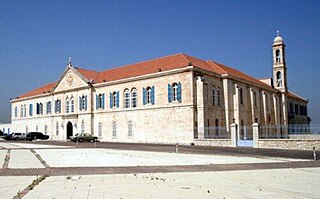
The Maronite Church is an Eastern Catholic sui iuris particular church in full communion with the Pope and the worldwide Catholic Church, with self-governance under the Code of Canons of the Eastern Churches. It is headed by Patriarch Bechara Boutros al-Rahi since 2011. Officially known as the Syriac Maronite Church of Antioch, it is part of Syriac Christianity by liturgy and heritage.

Oriental Orthodoxy is the fourth largest communion of Christian churches, with about 76 million members worldwide. As one of the oldest religious institutions in the world, it has played a prominent role in the history and culture of Armenia, Egypt, Eritrea, Ethiopia, Sudan and parts of the Middle East and India. An Eastern Christian communion of autocephalous churches, its bishops are equal by virtue of episcopal ordination, and its doctrines can be summarised in that the communion recognizes the validity of only the first three ecumenical councils.

The Ethiopian Orthodox Tewahedo Church is the largest of the Oriental Orthodox Christian churches. One of the few pre-colonial Christian churches in Sub-Saharan Africa, the Ethiopian Orthodox Tewahedo Church has a membership of between 45 and 50 million people, the majority of whom live in Ethiopia. It is a founding member of the World Council of Churches. The Ethiopian Orthodox Tewahedo Church is in communion with the Coptic Orthodox Church of Alexandria, having gained autocephaly in 1959.
See also: Enhanced Strong’s Lexicon, James Strong, Oak Harbor, WA, Logos Research Systems, 1995. (Αρ. λέξης 03742). The Anchor Bible Dictionary, Freedman, David Noel, New York, Doubleday, 1997/1992. Pseudo-Dionysius Areopagita, De coelesti hierarchia, [Patristische Texte und Studien 36. Berlin: De Gruyter, 1991]
Εγκυκλοπαίδεια, «Πάπυρος, Larousse, Britannica», Εκδόσεις Πάπυρος, Αθήνα, 1976/2006 Catholic Encyclopedia Ο κόσμος των αγγέλων Αρχιμανδρίτου Ιωάννου Καραμούζη


